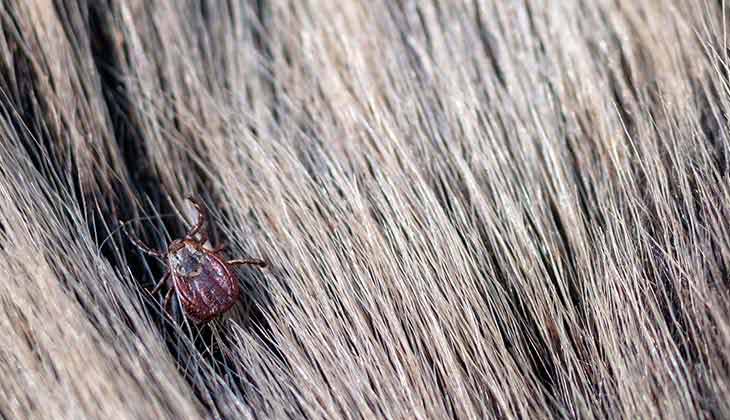Your Dog and Rickettsial Infections:
Watch Out for this Tick Transmitted Disease of Dogs
HEALTH & PROTECTION
28 Mar, 2022
6 minutes

As a pet parent, you probably know how annoying ticks can be to your beloved pooch and you’ve probably thought a lot about flea and tick prevention. As we’ve discovered in previous articles on this same topic, in addition to making your dog itchy and uncomfortable, ticks can also transmit serious diseases to your dog, which can sometimes even be fatal.
Different species of ticks can carry multiple different diseases. In this article, we’re going to look at a bacterial group called the Rickettsia, which cause a variety of infectious tick transmitted diseases. Diseases caused by the Rickettsia may go under the more common names of “Spotted Fever,” or “Rocky Mountain Spotted Fever,” while other names for infections by bacteria in this group are Anaplasmosis and Ehrlichiosis.

Where are Rickettsial Infections of Dogs Most Likely To Occur?
There are a variety of very small bacteria called “Rickettsia” that can cause disease in dogs and these bacteria are found worldwide. They depend on ticks for transmission from dog to dog, therefore there is a greater infection risk in areas with large numbers of ticks.
These bacteria tend to fall into one of two patterns of transmission. Some of the Rickettsia are usually transmitted by Brown Dog Ticks, that are common in the Philippines, which prefer to feed on dogs. Therefore, disease caused by this group of Rickettsia may be identified wherever there are dense groups of dogs that are not receiving effective tick control.
Other Rickettsia are more often found infecting and causing disease wherever dogs have contact with natural areas with ample populations of wildlife and ticks that feed on wildlife.

Favorable Climate
The ticks that spread these diseases are found in many different climates around the world and therefore, the diseases are also found in many areas.
Brown Dog Ticks, for example, thrive in high temperatures and may be found in tropical, humid regions and in warm, arid areas. Hence, Rickettsia transmitted by Brown Dog Ticks are often more common in these warmer regions.
In contrast, the areas where Rickettsia that infects wildlife are found vary widely, from warmer climates to more temperate areas, depending on the types of carrier ticks.
Changes in climate and habitat, along with increases in wildlife populations and new introductions of tick-infested animals are resulting in the spread of infections with Rickettsia of both types to new areas and an overall increase in disease risks for dogs.

How Does A Dog Become Infected with Rickettsia?
Tick bites are the most common source of infection for dogs, although Rickettsia are occasionally transmitted in a blood transfusion or by direct contact with blood of contaminated materials.
Infected dogs, either showing signs of disease or with unapparent infections, then help to spread the disease by infecting ticks that feed on them.
Infected deer or wild ruminants (such as cattle, antelope, bison, etc.) provide a food source that supports some adult ticks. These adult ticks do not usually infect the deer, but they can spread some Rickettsia infections through their eggs to the next generation of ticks. The Rickettsia are maintained primarily in small mammals, such as mice, that are fed on by immature ticks.
Dogs living anywhere where there are lots of infected ticks have a high probability of becoming infected. When an infected tick bites a dog it injects some saliva at the bite site before and during feeding.
Rickettsia are transferred from the tick into the dog with saliva. The risk of infection increases for a dog the longer that the tick is able to feed.

What Behaviors Put A Dog At Risk For Rickettsia?
Any dog that gets a tick bite is at risk of infection and disease caused by Rickettsia, although infections are more common when dogs share their living spaces with numerous other dogs and where there are well-established Brown Dog Tick populations. Also, dogs that have an active, outdoor lifestyle with frequent visits to natural environments where ticks are found face a higher risk of tick bite and subsequent infection. Finally, dogs that are not protected by tick control treatments also face a higher risk of tick bites and possible infection.
There may be some variations in breed-related susceptibility to tick bites and Rickettsia disease risk, for example veterinarians have reported the following findings:
- There can be five-times as many brown dog ticks attached to Cocker Spaniels compared to Beagles in dogs housed together in a kennel where the ticks are present. The thought is that Beagles are less likely to get bitten by a tick.
- German shepherds and Siberian Huskies seem to get more severe disease signs of Ehrlichiosis after catching the infection from a tick bite.
- A few individual German shepherds and English Springer Spaniels have a particular genetic change that can lead to more severe disease following infection.
Although large dog populations can increase the risk of tick exposure, there is no increased risk for direct transmission of Rickettsia directly from dog to dog.
To know more on how you can keep your pet tick free all year round with just four treatments, visit http://www.bravecto.com.ph for more information.
There is still a lot more to learn about Rickettsia, and in Part Two of this series, we will dive into the signs to watch for that indicate an infection from Rickettsia, disease treatments, and advice for keeping your precious pup protected from this infection.
RECOMMENDED
POPULAR PAGES





